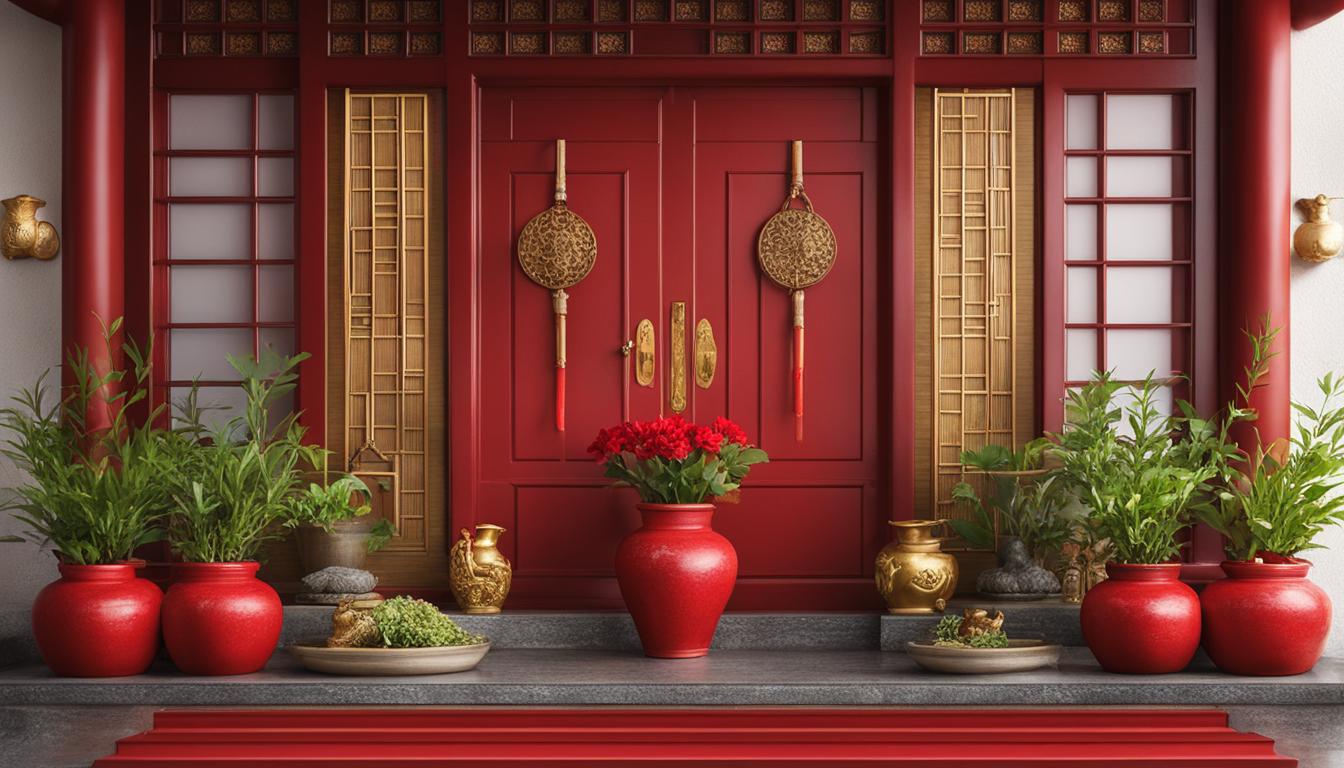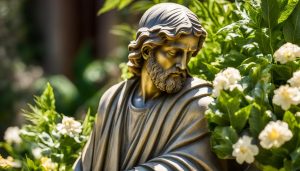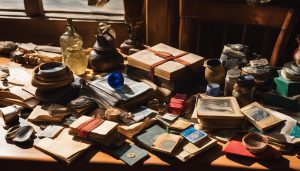Selling a house can be a challenging process, and as a homeowner, you’re constantly looking for ways to increase your chances of a successful sale. Have you ever wondered if there are good luck items or rituals that can help create positive energy and attract the right buyer? In this article, we will explore various good luck things to sell a house and their potential impact on the selling process.
Contents
- 1 Using Spells and Rituals to Sell a House
- 2 The Tradition of Burying a St. Joseph Statue
- 3 Exploring the History and Usefulness of the St. Joseph Statue
- 4 Understanding Good Luck Symbols in Different Cultures
- 5 Conclusion
- 6 FAQ
- 6.1 Are good luck items and rituals effective in selling a house?
- 6.2 What are some examples of spells and rituals used to sell a house?
- 6.3 How does burying a St. Joseph statue help in selling a house?
- 6.4 What is the history behind burying a St. Joseph statue to sell a house?
- 6.5 What are some good luck symbols in different cultures that can be used to sell a house?
- 6.6 Do numbers play a role in selling a house with good luck?
- 6.7 What factors contribute to successfully selling a house?
- 7 Source Links
Key Takeaways:
- Using spells and rituals, such as Wiccan spells or spiritual cleanses, can create positive energy and attract potential buyers.
- Burying a St. Joseph statue in the garden is a popular tradition believed to bring good luck in selling a house, although its effectiveness is subjective.
- Good luck symbols vary across cultures, such as conch shells, elephants, four-leaf clovers, and lucky bamboo.
- Numbers, like 7, 8, and 9, are often considered lucky and incorporating them into the selling process can enhance the perception of luck.
- While good luck items and rituals can create a positive mindset, success in selling a house also depends on market conditions, pricing, and preparation.
Using Spells and Rituals to Sell a House
Selling a house can sometimes feel like an uphill battle, but some homeowners turn to spells and rituals to help attract positive energy and improve their chances of a successful sale. These practices are often rooted in the belief that creating a harmonious environment and setting the right intentions can make a difference in the selling process.
One popular approach is to incorporate feng shui principles into the home staging process. Feng shui is an ancient Chinese practice that focuses on arranging spaces to promote balance and harmony. By strategically placing furniture, utilizing calming colors, and ensuring good flow of energy, homeowners hope to create a space that appeals to potential buyers and encourages a positive buying decision.
Another common ritual involves the use of lucky charms or symbols. Homeowners may place objects such as a horseshoe, a statue of a laughing Buddha, or a symbolic piece of artwork to attract good fortune and positive vibes. These items are believed to emit positive energy and create a welcoming atmosphere for potential buyers.
| Lucky Charms | Meaning |
|---|---|
| Horseshoe | Represents good luck and protection |
| Laughing Buddha | Symbolizes happiness, wealth, and overall good luck |
| Dreamcatcher | Believed to ward off negative energy and promote positive dreams |
| Elephant | Considered a sacred animal that brings strength and good fortune |
While these spells, rituals, and lucky charms may not have concrete scientific evidence supporting their effectiveness, they can serve as a way for homeowners to channel positive energy and approach the selling process with optimism. Whether you choose to believe in their power or not, incorporating these practices can create a sense of intention and invite good vibes into the selling experience.
The Tradition of Burying a St. Joseph Statue
When it comes to selling a house, people often turn to age-old traditions and superstitions in the hopes of attracting good luck and a successful sale. One such tradition is the practice of burying a statue of St. Joseph in the garden. This ritual, believed to bring good fortune to the selling process, has been passed down through generations and is still popular among home sellers today.
The origin of this tradition can be traced back to St. Teresa of Avila, a devoted nun who buried a medal with the image of St. Joseph to acquire land for a new convent. Over time, the act of burying a St. Joseph statue has become a widespread belief among homeowners looking to sell their properties.
Although burying a St. Joseph statue is often considered a symbolic gesture rather than a scientifically proven method, many people claim to have had positive experiences after performing this ritual. The idea is that by burying the statue, you are enlisting the help of St. Joseph, the patron saint of home and family, to intercede on your behalf and attract a buyer for your house.
Stories of Success
“I was skeptical at first, but after burying the St. Joseph statue in my backyard, I received an offer on my house within a week. It was truly amazing!” – Jane, a homeowner who successfully sold her house after burying a St. Joseph statue
“My grandmother always told me about the power of the St. Joseph statue. I decided to give it a try, and within a month, I had multiple offers on my property. I truly believe it made a difference.” – Mike, a homeowner who sold his house using the St. Joseph statue
While the effectiveness of burying a St. Joseph statue may vary from person to person, many sellers find comfort in this tradition and view it as a way to invite positive energy into the selling process. Whether it’s a matter of faith or simply a symbolic gesture, the act of burying a St. Joseph statue can serve as a reminder to stay optimistic and hopeful during the sometimes stressful experience of selling a house.
Exploring the History and Usefulness of the St. Joseph Statue
The practice of burying a St. Joseph statue as a means to sell property has a long-standing history that dates back to the 16th century. While its popularity gained traction in the 1990s due to various success stories shared online, the effectiveness of this practice remains subjective and unproven scientifically.
Although many individuals swear by the power of the St. Joseph statue, it is important to consider other factors and methods when attempting to sell a house. It is crucial to remember that the sale of a property depends on a combination of elements, including market conditions, pricing, and overall preparation.
While the tradition of burying a St. Joseph statue may hold sentimental value for some, it is essential to approach the selling process with a pragmatic mindset. Relying solely on the belief in good luck items or rituals may not guarantee a successful sale. It is advisable to explore diverse strategies and consult with real estate professionals to ensure all available options are considered.
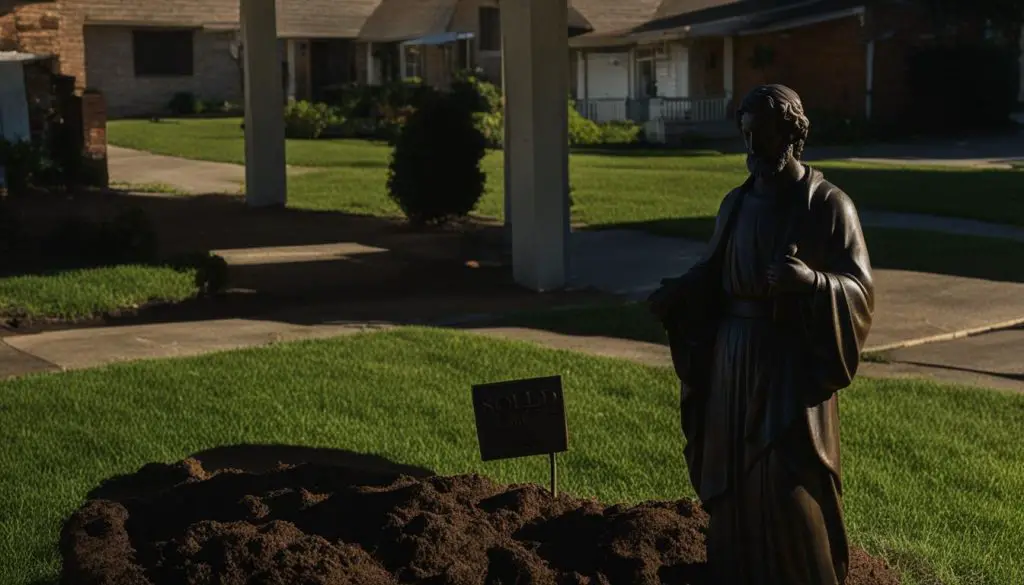
The History of Burying a St. Joseph Statue
“The tradition of burying a St. Joseph statue can be traced back to the 16th century, with its origins rooted in the story of St. Teresa of Avila. Although its effectiveness is debated, many home sellers continue to practice this tradition in hopes of attracting good luck and a successful sale.”
Despite the lack of scientific evidence supporting the direct influence of the St. Joseph statue on the sale of a house, its historical significance and cultural significance make it an intriguing aspect of the home-selling process. While some may view it as a meaningful tradition, others may approach it with skepticism.
Ultimately, the decision to incorporate the St. Joseph statue or any other good luck item in the selling process is a personal one. It is important to consider individual beliefs and consult with real estate professionals for guidance and expertise. By combining practical strategies and a positive mindset, sellers can increase their chances of achieving a successful and timely sale.
Understanding Good Luck Symbols in Different Cultures
In many cultures, good luck symbols play a significant role in attracting positive energy and creating a favorable environment. Incorporating these symbols into the process of selling a house can potentially enhance the selling experience and attract potential buyers. Let’s explore some auspicious objects from different cultures that are believed to bring luck and positive energy when selling a house.
Indian Culture – Conch Shells
In Indian culture, conch shells are considered to be powerful symbols of good luck and prosperity. They are believed to bring positive vibrations and purify the environment. Many homeowners place conch shells at the entrance of their homes to invite positive energy and protect against negative influences. When selling a house, incorporating conch shells in the decor or having them as part of a staging setup may create a welcoming ambiance and attract potential buyers.
Hinduism – Elephant
In Hinduism, the elephant symbolizes strength, wisdom, and good luck. Ganesha, the elephant-headed deity, is worshipped as the remover of obstacles and the bringer of good fortune. Using elephant motifs in home decor or displaying elephant figurines may add a touch of auspiciousness and positive energy to the selling process.
Ireland – Four-Leaf Clovers
In Ireland, four-leaf clovers have long been associated with good luck. Finding a four-leaf clover is believed to bring great fortune and is considered a rare and lucky occurrence. Including four-leaf clover motifs or decorations with clover leaves in the house may create a sense of luck and intrigue for potential buyers.
| Culture | Lucky Symbol |
|---|---|
| India | Conch Shells |
| Hinduism | Elephant |
| Ireland | Four-Leaf Clovers |
These are just a few examples of good luck symbols from different cultures. Incorporating these symbols into the selling process can add a touch of positive energy and create an inviting atmosphere. However, it’s important to remember that the effectiveness of these symbols is subjective and may vary from person to person. Ultimately, the success of selling a house relies on a combination of factors, including market conditions, pricing, and preparation.
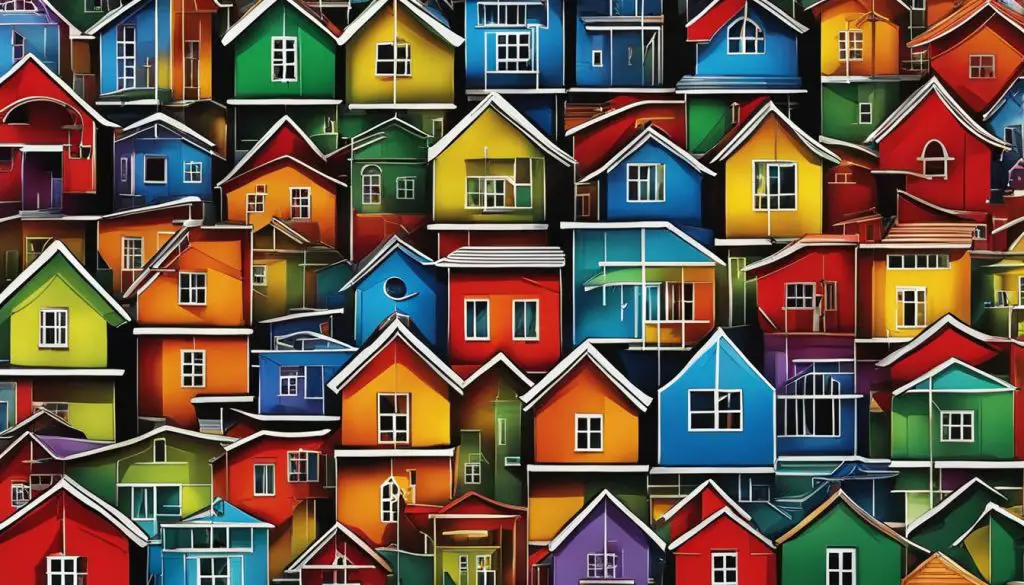
Using Lucky Numbers in Pricing and Marketing
When pricing your house, consider using lucky numbers to create a positive impression. For example, if the estimated value of your house is $350,000, you could consider pricing it at $358,888 to incorporate the lucky number 8. This subtle adjustment can catch the attention of potential buyers who may associate the number with good fortune.
In marketing materials, highlight any addresses or features of the house that include lucky numbers. For instance, if your house is located at 777 Pine Street, emphasize the triple sevens to attract buyers who believe in the power of lucky numbers.
| Lucky Number | Cultural Significance | How to Incorporate |
|---|---|---|
| 7 | Hinduism – abundance and success | Price your house with numbers that include 7, or emphasize features associated with luck. |
| 8 | Chinese culture – prosperity and good fortune | Incorporate the number 8 in the price, address, or marketing materials. |
| 9 | Chinese culture – completeness and fulfillment | Include the number 9 in the address or pricing of your house. |
By understanding the cultural significance of lucky numbers and incorporating them strategically, you can create a positive impression and enhance the perceived luck associated with your house. Remember, though, that luck is subjective, and potential buyers may have different beliefs and preferences. It is important to consider other factors such as market conditions and overall presentation to increase your chances of a successful sale.
Conclusion
Incorporating good luck items and rituals can create a positive selling experience and potentially attract the right buyer for your house. While belief in these practices may vary, they can help create a sense of positive energy and enhance the overall selling process.
Whether you choose to use spells and rituals, bury a St. Joseph statue, or incorporate symbols and lucky numbers, the goal is to set intentions and create an inviting atmosphere for potential buyers. Remember, selling a house successfully relies on a combination of factors, including market conditions, pricing, and preparation.
So, why not embrace the idea of selling your house with good luck? Give it a try and see if it makes a difference. Good luck charms and rituals can’t guarantee a sale, but they can certainly help create a positive mindset and attract the right energy into your selling journey. Best of luck with your house sale!
FAQ
Are good luck items and rituals effective in selling a house?
While belief in good luck items and rituals may vary, incorporating these practices can create a positive mindset and potentially attract the right buyer. However, the success of selling a house depends on various factors.
What are some examples of spells and rituals used to sell a house?
Some people use green candles and bay leaves in a Wiccan spell to attract buyers. Others focus on creating positive energy through spiritual cleanses and releasing negative attachments.
How does burying a St. Joseph statue help in selling a house?
Burying a St. Joseph statue is believed to bring good luck and attract the right buyer. However, its effectiveness is subjective and not scientifically proven.
What is the history behind burying a St. Joseph statue to sell a house?
The tradition dates back to the 16th century and gained popularity in the 1990s due to stories circulating on the internet. However, there is no scientific basis to support its direct influence on selling a house.
What are some good luck symbols in different cultures that can be used to sell a house?
Examples include conch shells in India, elephants in Hinduism, four-leaf clovers in Ireland, and lucky bamboo in China. These symbols are believed to bring luck and positive energy.
Do numbers play a role in selling a house with good luck?
Yes, numbers are often associated with luck in various cultures. For example, the number 7 is considered lucky in Hinduism, while 8 and 9 are auspicious in Chinese culture.
What factors contribute to successfully selling a house?
Aside from good luck items and rituals, other factors such as market conditions, pricing, and preparation play crucial roles in selling a house.

